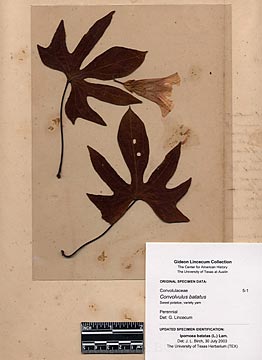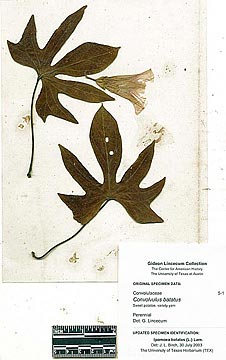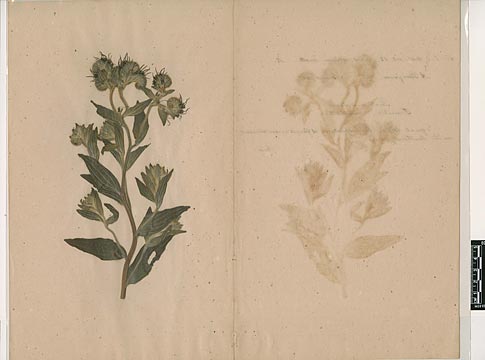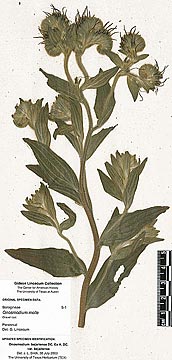Scanning the Gideon Lincecum Collection for Web Presentation
Joanne L. Birch, in 2004 in conjunction with her Master's research, created a scan archive of all plant specimens and original notes in the Lincecum Collection of the Dolph Briscoe Center for American History, The University of Texas at Austin.
A specimen label was placed in the bottom right corner of the specimen prior to scanning. The label includes the determination of the specimen by Lincecum along with other botanic data provided by Lincecum, when provided, such as the date and location of the specimen collection. Lincecum's spelling errors for the Latin binomial were retained on the specimen labels. The current determination of the specimen by Joanne L. Birch was provided at the bottom of the specimen label. Where multiple fragments representing more than one taxon are contained on a single specimen sheet a separate label was included for each fragment. The uppermost label refers to the fragment on the far left of the specimen sheet and the lower labels refer to additional fragments moving from left to right respectively. A rule was included on each of the images [These labels are no longer together with the specimens.]
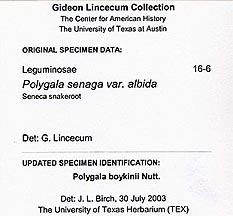
In 2009 the Plant Resources Center (PRC) of The University decided to create a Virtual Herbarium, hoping to optimize the botanical features of the scanned specimens and Lincecum's notes for web presentation. In the past 5 years scanning technology has improved significantly, and while the 2004 scans were in most cases of quite good quality, some 70 specimens were scanned anew using state-of-the-art technology in the Plant Resources Center (see below for scanner details). This rescanning involved either rescanning specimens for which the 2004 scan had some serious problem (about 15), or rescanning specimens of particular interest or significance. All scans have been processed using graphics software (i.e., Adobe Photoshop) to reveal as much detail as possible [see below].
Lincecum's specimens were originally in the form of pressed dried plants or plant portions placed inside a once-folded sheet of paper (folder) with notes in Lincecum's hand on the outside of the folder; the specimen inside was either attached to the paper or loose. At the time of the 2004 scans 107 specimens were attached to the specimen sheet under a mesh weave and 236 specimens were placed in Mylar envelopes and inserted into the folded specimen sheet. Two specimen sheets containing taxonomic identification and ethnobotanic data lacked plant material.
The specimens of the Lincecum Collection are now preserved in three forms,
- The pressed specimen is enclosed in a plastic sheath placed inside Lincecum's folder. Although the 2004 scans were made on top of this original paper, more recent scans were made after placing the specimen on a white background. In several instances we were thus able to present both sides of a pressed specimen. (A 2004 scan and its edited form are shown below, reduced.)
- Alcea rosea — both sides presented in virtual herbarium; on white sheet
- Galium boreale / Galium pilosum — one side; on original sheet
- Polygala polygama — both sides shown but only one side presented in virtual herbarium; on white sheet
- The pressed specimen is attached to Lincecum's paper and this has been placed as a unit in a plastic sheath (with the folder opened flat). The specimen can thus only be scanned together with the original paper backing.
- The pressed specimen is attached to Lincecum's paper with netting (original), with no plastic sheath; the specimen folders are stored unfolded. Both the netting and the browned backing thus create difficulties for optimizing the presentation.
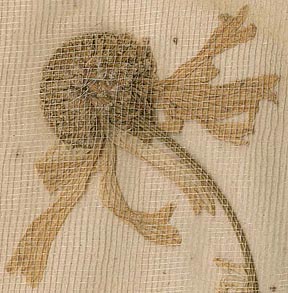
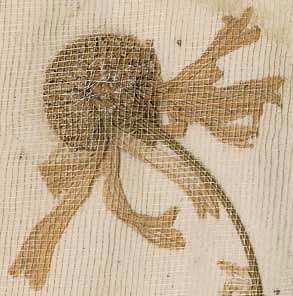
Leptopoda / Helenium autumnale
(Original detail on the left / as edited on the right.) [For additional information.]
Graphic Modification for the Virtual Herbarium
Scans of Lincecum's specimens and notes written on the specimen pages have been modified to optimize web presentation of the botanical specimens using Adobe Photoshop. Modifications were made with three goals in mind:- Images presented must be appropriately small to facilitate downloading of the specimen web page first encountered on the site. These images are all 720 dpi (10 monitor inches) in height, but provide links to significantly larger versions, ranging in size from 300 KB to 1 MB (the largest being those scanned anew in 2009). Similarly, the data sheets with Lincecum's notes were reduced to 10 inches wide. Cropping images was commonly used to eliminate empty background.
- Images must be sharp. Sharpening with Photoshop's 'Unsharp Mask' procedure was performed on all 'raw' scans (Amount 90, Radius 0.5, Threshold 0). Subsequently, every time an image was reduced in size, the Unsharp Mask was used at an 'Amount' deemed appropriate (between 120 and 65) depending on the degree of reduction. Care was taken that sharpening did not introduce 'boundary lines' on the image.
- In so far as reasonable color adjustments must remove tints/casts resulting as scan artifacts as well as background color from Lincecum's original papers. [To see the range of color variation in the 2004 scans.] This has generally resulted in relatively light backgrounds. Care was taken that making the background lighter and other color adjustments did not also impact the specimen image. This was a complicated process, done image by image, utilizing Photoshop's tools for 'Levels,' 'Brightness,' and 'Contrast' as deemed appropriate to bring out as much definition in the specimen as possible. [Note the 'before & after' Ipomoea images above].
Scanners
The majority of scans done in 2004 used an Epson Perfection Flatbed Scanner at the School of Biological Sciences, The University of Texas at Austin. Larger specimens were scanned using an Epson 1640XL flatbed scanner at the Digitization Center, Digital Library Services Division, The University of Texas at Austin. Specimens were scanned at 400 dpi, resized in some cases, and stored as 400 dpi jpeg files.The 70 scans done in 2009 used the Plant Resources Center's HerbScan setup, a herbarium scanning system developed first at the Kew Botanic Gardens and now widely used in several international interinstitutional projects funded by the Mellon Foundation. The PRC's Herbscan, provided by the Mellon Foundation for a Latin American Plants Initiative (LAPI) project, incorporates an Epson Expression 10000XL flatbed scanner modified for upside-down scanning. Specimens were scanned full-size at 600 dpi and stored as TIFFs; the resulting large files were downsized and converted to JPGs for web presentation.
